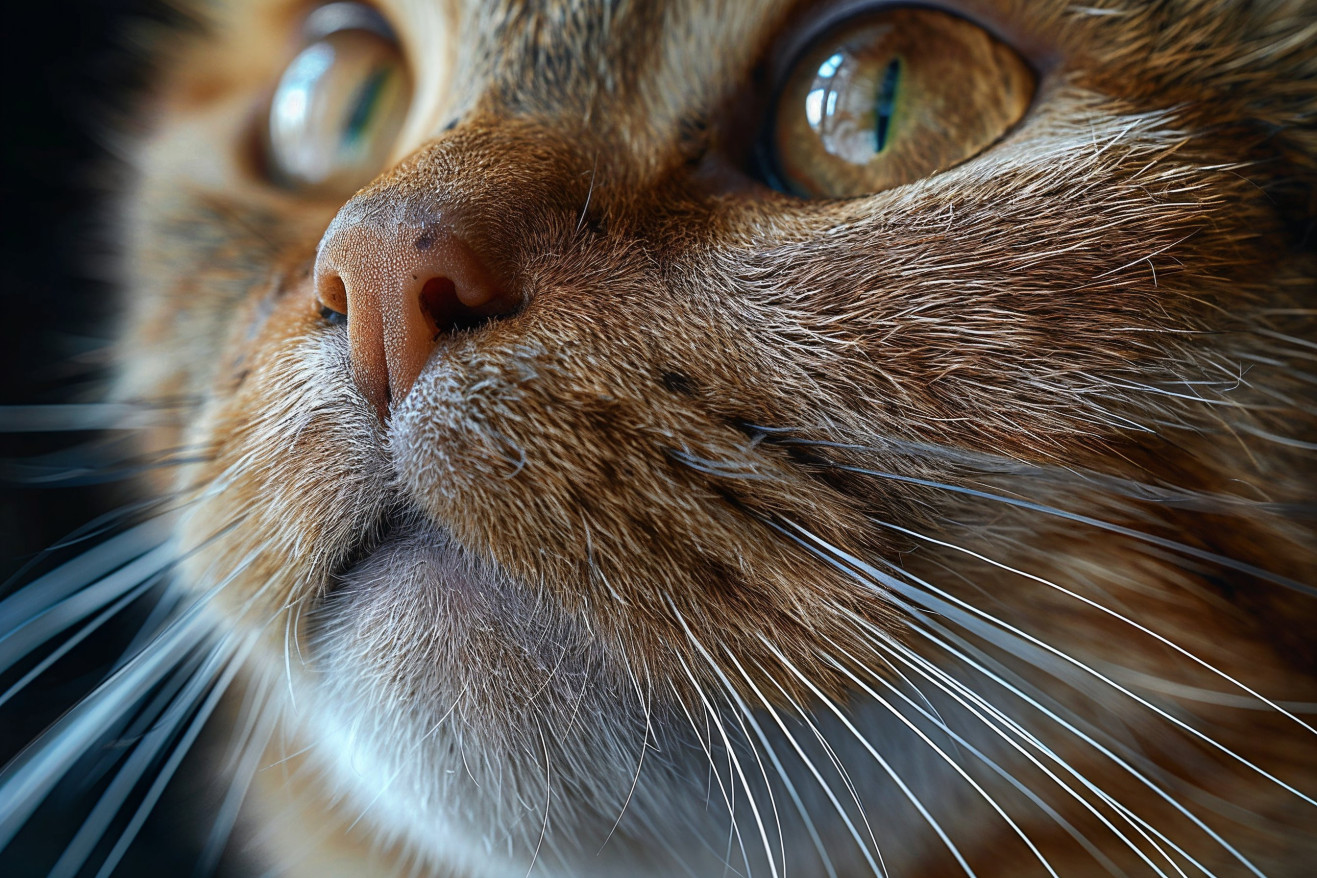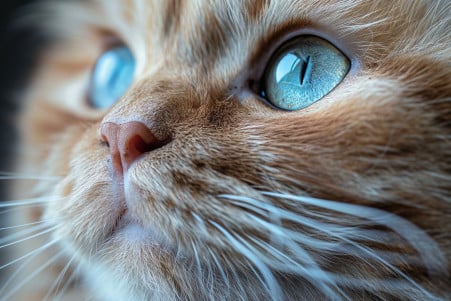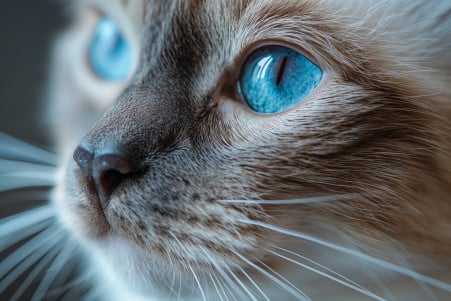How Many Whiskers Do Cats Have? Exploring Feline Whisker Anatomy
9 June 2024 • Updated 8 June 2024

If you've ever looked at your cat, you know how adorable their whiskers are, but do you know exactly how many of those long, sensitive hairs they have? Most cats have about 24 whiskers, 12 on each side of their face. Whiskers are long, thick, deeply rooted hairs known as "vibrissae" that help cats move around and detect objects in their environment. The pattern and number of whiskers is similar from cat to cat, although there may be a little variation in the number.
This article covers studies by biologists, veterinarians, and other animal researchers who have delved into the unique anatomy and function of a cat's whiskers. You'll learn why these special hairs are so important to cats, how the pattern of whiskers is determined, and how cats use their whiskers in their everyday lives. Knowing more about whiskers can help you appreciate the incredible sensory world your cat lives in.
How many whiskers do cats have?
Why Do Cats Have Whiskers?
Cat whiskers, also known as vibrissae, are long, thick, and sensitive hairs that are located on a cat's face, particularly above the eyes, on the cheeks, and on the back of the front legs. As the McGehee Clinic explains, these hairs are rooted more deeply than other hairs in a cat's body and are connected to the muscular and nervous systems, which means they can detect even the smallest changes in the environment.
Whiskers are full of nerve endings that send information directly to a cat's brain, which means they can sense things like air currents, the size and shape of objects, and the movement of prey. This ability is important for hunting, navigation, and avoiding obstacles in a cat's daily life.
Whiskers on a cat's muzzle, chin, and even the backs of their front legs, as Liz's Kitty Bootcamp points out, help cats get a better sense of their surroundings. This is especially important in low light or when cats are close to objects, which can limit their vision. In these cases, the whiskers act as an extension of the cat's other senses, providing them with information about their environment.
While whiskers provide cats with a number of sensory benefits, they can also cause discomfort if they are overstimulated. Pumpkin Pet Insurance explains, that "whisker fatigue" can occur when a cat's whiskers are overstimulated by rubbing against objects, like the sides of food or water bowls, which can cause stress and lead to changes in behavior during mealtime.
Why It's Important to Keep a Cat's Whiskers
Whiskers are vital for a cat's sense of spatial awareness and should never be cut or trimmed, according to Spot Pet. If a cat's whiskers are cut or trimmed, it can lead to disorientation and make it harder for the cat to get around. As Dr. Justine Lee points out, the whiskers are attached to hair follicles and sinuses that have nerve innervation, so cutting them can be painful for the cat.
While it's normal for cats to shed their whiskers, Palos Animal Hospital warns that excessive shedding could be a sign of an underlying health problem that needs to be checked out by a vet. If a cat's whiskers are cut for a medical reason, they should grow back in 2-3 months, provided the hair follicle isn't damaged.
To avoid whisker fatigue and make sure your cat is comfortable and happy, the East Bay Times suggests using appropriately sized food and water dishes. Since cats use their whiskers to measure the size of the space around them, smaller dishes can be uncomfortable.
Anatomy and Evolution of Cat Whiskers
Whiskers, or vibrissae, are a type of hair that is thicker and stiffer than the rest of a cat's fur. Per the Londolozi Blog, this modification has turned the hair into a specialized touch organ that provides cats with a wide range of sensory information. Whiskers can also vary in length and color by breed, with larger breeds like the Maine Coon having longer whiskers, as pointed out by The Tiniest Tiger.
Whiskers are rooted deep in a cat's skin and are connected to their musculature and nervous system, per Discover Wildlife, which allows for fine-tuned control and sensation. This unique anatomy likely gave early mammals a big leg up when it came to moving and hunting in dim light. In addition, cats have voluntary control over their whiskers, which means they can move them to convey their mood and feelings.
Given the special structure and evolutionary history of cat whiskers, it's clear that these hairs play a critical role in feline behavior and survival. Knowing more about the special anatomy of whiskers also helps us understand the sensory abilities that have helped cats become such effective hunters and navigators.
Whiskers in Action: How Cats Use Their Sensory Superpowers
Cats use their whiskers to sense even the smallest changes and movements in their environment, which helps them move and hunt in a way that is highly effective, especially in the dark. VCA Animal Hospitals explains that the highly sensitive whiskers provide information about the size, shape, and speed of objects in the immediate area, which helps cats stay aware of what's going on around them.
The length of a cat's whiskers is equal to the width of its body, PetMD says, which helps cats determine if they can fit through small spaces or openings. Whiskers in different locations on a cat's body have different purposes, with the whiskers above the eyes helping cats sense the movement of their prey and the whiskers on the front legs helping them navigate their environment.
The position and movement of a cat's whiskers can also indicate how a cat is feeling and what it is thinking, Dr. Elsey's explains. Whiskers that are relaxed and sticking out from the face indicate a relaxed cat, while whiskers that are pulled back against the face indicate a cat that is feeling aggressive or frightened. Cats use their whiskers to a great extent in their daily lives, which means that they are an important part of a cat's overall health and well-being.
Conclusion: Understanding the Amazing Anatomy of Cat Whiskers
Cat whiskers, or vibrissae, are highly specialized sensory organs that play a critical role in a cat's life. With 24 whiskers on their face and additional whiskers on other parts of their body, cats depend on these tactile hairs for hunting, navigation, and spatial awareness. If a cat's whiskers are cut or trimmed, it can lead to disorientation and an inability to sense their environment, so it's important to protect these important structures.
Learning about the unique anatomy and functions of cat whiskers can help you appreciate the remarkable sensory abilities of your feline friends and ensure their comfort and well-being.


